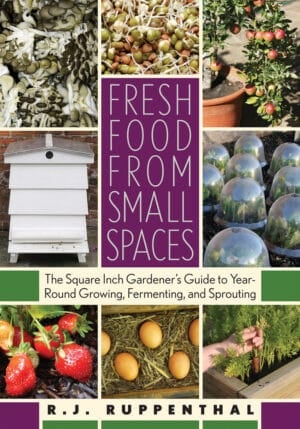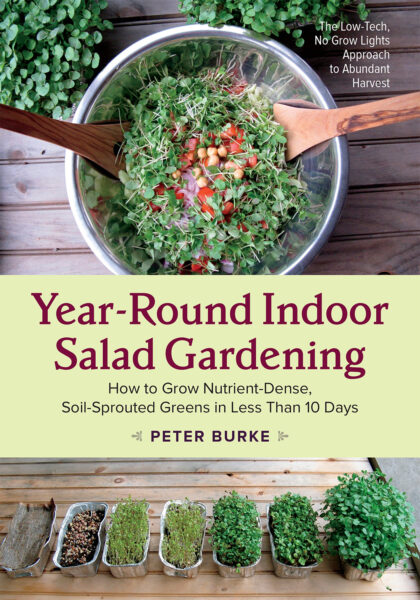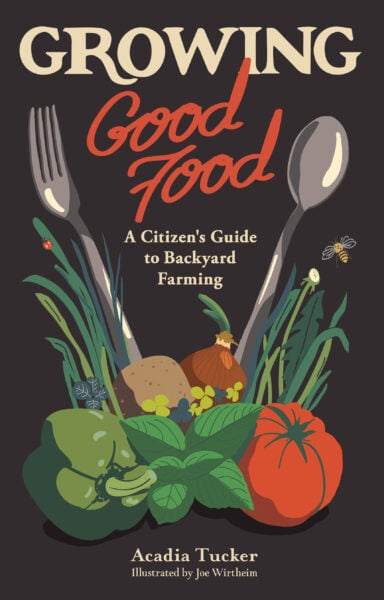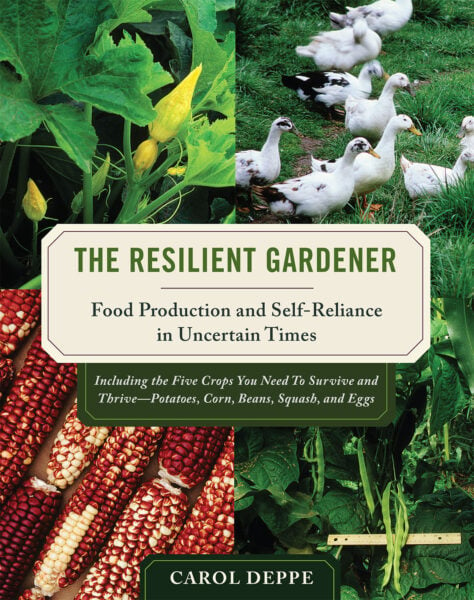DIY: Make a Self-Watering Planter
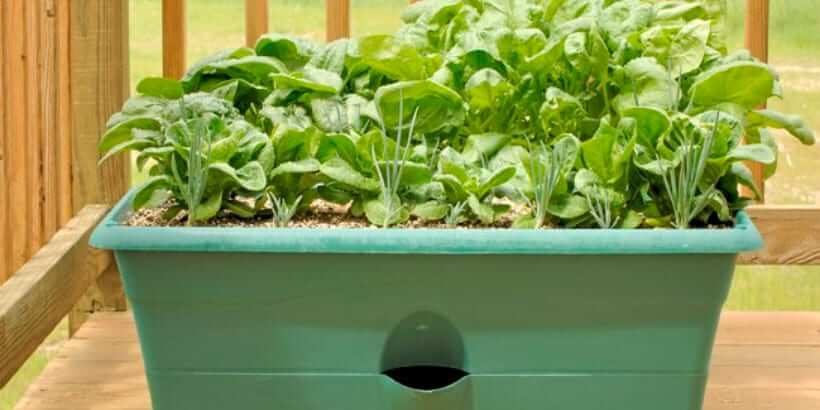
Whether you live in a four-season climate or a small apartment in the city, fresh food at your fingertips is easier than you think! Just follow the directions for this self-watering growing container and you’ll have an abundance of produce in no time.
The following is an excerpt from Fresh Food From Small Spaces by R. J. Ruppenthal. It has been adapted for the web.
If you are on a bootstrap budget, you can make a self-watering growing container yourself. I have made several of my own, using Rubbermaid or Sterilite storage containers, that grew some mighty fine vegetables. If you have a couple of extra 5-gallon plastic buckets, or a metal or plastic washtub, you could modify any of these as well. All you need is the container plus a few materials, which can be purchased for around $10 at your local hardware store or garden center. If you are buying a container, then the darker plastic colors are best because they hold in the heat well (unless too much heat is a problem in your climate, in which case you should go with white). Most hardware stores, drugstores, or home centers stock some of the large, featureless plastic basins or storage containers that work best for this project.
Raw materials for making a self-watering planter box for vegetables
-
Large plastic storage bin (lid not pictured)
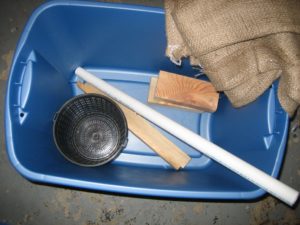
-
Pond basket, snack tray, or strainer for “soil foot”
-
Plastic watering pipe
-
Wood blocks or other attachable supports
-
Burlap, mesh, or landscape fabric to screen watering pipe
-
Also needed: staples or screws.
The basic design of self-watering containers is that they have a water reservoir below the growing chamber. These two chambers are separated by a rack of some sort, which holds most of the soil above the water. This separating rack can be made from the top of a Rubbermaid or Sterilite container box that is cut to fit inside, or else you could use two containers, drill holes in the bottom of one, and nest that inside the other.
The water reservoir does not need to be as tall as the growing chamber, perhaps one-fourth to one-third as tall. You then need to put a larger hole or two in this rack for one or more “soil feet,” which will sit in the water, holding a small amount of soil that wicks up the moisture into the main soil and toward the plant’s roots. To hold the “soil feet” in the water, a basket of some sort can be inserted there and then packed with soil for each of the soil “feet.” A snack tray or pond basket can do the trick, or you could even use an old coffee can, plastic nursery pot, or 2-liter soda bottle base that is cut to fit and then punctured with holes.
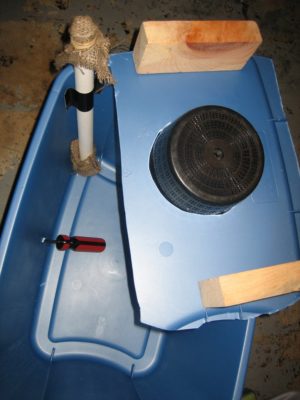
-
Cut lid to fit inside bottom of container and cut hole in center for pond basket. Also allow space
-
in one corner for watering pipe.
-
Attach wood blocks or other support using screws or staples.
-
Cut plastic pipe to fit height, allowing room for watering once soil is added. A piece of tape will hold it in the corner until soil is added.
-
Here, burlap is used to screen watering pipe from any soil blockage (at bottom) and double wrapped-at top to prevent insects. This “cap” is removed for watering. Landscape fabric or mesh screen also will work.
Just below the rack’s level on the outside of the main container, you should drill or puncture a small drainage hole, which allows any excess water to drain out. The final crucial piece, before the soil goes in, is some sort of watering tube that runs down the inside of one corner. Buy a foot or so of plastic pipe or hose at your local hardware store and fix this to a corner with hot glue, twine, or a pipe fastener; make sure that the bottom of the pipe goes all the way down into the reservoir so it cannot get filled with soil; you also could cover the end with a mesh screen or landscape fabric to keep soil out. PVC has gotten a bad name because it can leach chemicals, so if this is a concern you can look for ABS plastic or consider investing a few more dollars for a pipe made of copper, aluminum, steel, silicon, or even bamboo (and, if this is a concern to you, then you also should start with a non-PVC container for the planter itself). The pipe should be wide enough so that you can water it easily with your watering can.
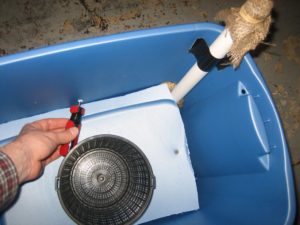
-
The cut lid with pond basket is flipped into the bottom of the container, where it rests on supports. The water reservoir will be below while the soil will go on top. The pond basket will hold the “soil foot,” which will sit in the water reservoir and wick up moisture into the rest of the soil. Plant roots will grow downward toward the water.
-
Punch a hole or two in the side of the container just above the water reservoir to allow for drainage in case of overwatering or heavy rains.
When you’re ready to fill the container, first pack the “soil foot” (or feet) with soil, wet this until moist, and then put in the remainder of your soil mix on top of this level so it is held in place by the rack. Water the soil from above until it’s the consistency of a wrung-out sponge. Repeat this for three or four days, and then begin filling it via the water reservoir.
The very top of the soil may dry out, but what’s really important is that there is lightly moist soil about 5 or 6 inches down. You can keep adding water right up until it starts spilling out of the drainage hole, meaning that it has reached full capacity at the height of the soil rack.
-
Fill pond basket with soil, pack it in tightly, and wet it down.
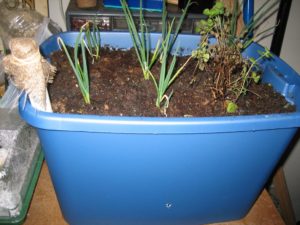
Fill remainder of container with good potting soil that is rich in organic matter.
-
Plant veggies and water well from the top. (This container shows onions and an oregano cutting.)
-
After the soil has been wetted down once, you can start watering via the pipe.
-
Add organic fertilizer to the top of the soil, and scratch it into the first few inches with a trowel. Plants will grow side roots to take this nutrition as they need it, while taproots will go down toward the water, making for very strong and happy plants.
-
Cover with mulch as desired to retain moisture and heat. If using plastic mulch, cover with plastic first and cut holes for plants or seeds.
Next, you should decide whether to mulch. Spreading some mulch on top of the soil preserves moisture and keeps the plants a bit warmer. If you decide to use black plastic sheeting as mulch, then first do the fertilizing as described below. Then cover with plastic mulch, which can be duct-taped to the sides or held down with the cutout frame of your container’s top if there is one. Cut an “x” in the black plastic wherever you want to put a plant. Whether or not you have mulched with black plastic, go ahead and plant your veggies next. Give each plant adequate root spacing according to the recommendations for that type of seed or transplant.
Once they are planted, if you have not yet fertilized, then side-dress the plants with a line or two of fertilizer along the top of the soil. Try to place this band a few inches from the plant stems, which will encourage better root growth. For most organic fertilizer, 2 to 3 cups per 2 cubic feet of soil is enough. (This is the Earthbox capacity.)
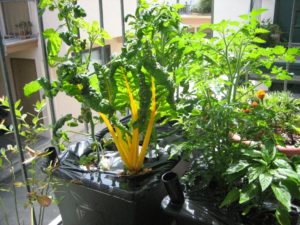 Finally, if you have not used black plastic, then you could now add any other kind of mulch: sawdust, grass clippings, leaves, etc. After the growing season, take out the old plants and try to remove the worst of their roots. Then scrape off any remaining fertilizer (or the first two inches of soil), top off with new soil mix, and then add your new plants and a fertilizer band as before. Every day or two, add water into the pipe or tube until the reservoir is topped off. You should be all set!
Finally, if you have not used black plastic, then you could now add any other kind of mulch: sawdust, grass clippings, leaves, etc. After the growing season, take out the old plants and try to remove the worst of their roots. Then scrape off any remaining fertilizer (or the first two inches of soil), top off with new soil mix, and then add your new plants and a fertilizer band as before. Every day or two, add water into the pipe or tube until the reservoir is topped off. You should be all set!
One caveat with self-watering planters: The size of the “soil foot” that sits in the water determines how wet your soil will be. If the soil foot is relatively wide (covering more than about 20 percent, horizontally, of the bottom area of the container), your soil will be quite moist. If you want to grow root or tuber vegetables in this container, such as carrots or potatoes, wetter soil can mean more disease problems, so you may need to use a narrower item for the soil foot to sit in. Root crops may also taste better if they are forced to grow downward toward the water. Here are three possible solutions to keep your soil a bit drier, any one of which should help:
- When you are making the self-watering box, limit the size of the soil foot, so that it covers no more than about 10 to 15 percent of the base. This will allow less water up into the soil and allow for healthy root crops.
-
Add a little more sand to your soil, which should limit the wicking action of its organic material.
-
Allow the water in the reservoir to be completely used up before watering again, and do not give it more than one day’s worth of water at a time. Advocates of a wet-dry growing cycle also can follow this suggestion, though in my experience, a self-watering container will grow healthy vegetables of all kinds without any special care.
Recommended Reads
Recent Articles
Garlic mustard: while known as “invasive,” this plant can be consumed in its entirety and has great nutritional value. Plus, the garlic-flavor is a perfect addition to any recipe that calls for mustard! The following are excerpts from Beyond the War on Invasive Species by Tao Orion and The Wild Wisdom of Weeds by Katrina…
Read MoreEveryone loves a refreshing, fermented, nutritious drink…even your garden! Take your fermentation skills out of the kitchen and into the garden by brewing fermented plant juice. The following is an excerpt from The Regenerative Grower’s Guide to Garden Amendments by Nigel Palmer. It has been adapted for the web. How to Make Fermented Plant Juice Fermented…
Read MoreOh, honeysuckle…how we love thee. If only there was a way to capture the sweet essence of this plant so we could enjoy it more than just in passing. Luckily, foraging and some preparation can help make that happen! Here’s a springtime recipe that tastes exactly like honeysuckle smells. The following excerpt is from Forage,…
Read MoreWant to see your crops thrive this upcoming growing season? The key is in soil fertility and health. Spend time maintaining your soil’s health to guarantee bigger and better crops come harvest time! The following is an excerpt from No-Till Intensive Vegetable Culture by Bryan O’Hara. It has been adapted for the web. What Is Soil Fertility?…
Read MoreIntroducing…your new favorite brunch dish! This whole broccoli frittata is packed with fresh, wildcrafted flavors that are bound to help you start your day off on the right foot. The following is an excerpt from The Forager Chef’s Book of Flora by Alan Bergo. It has been adapted for the web. RECIPE: Whole Broccoli Frittata…
Read More

